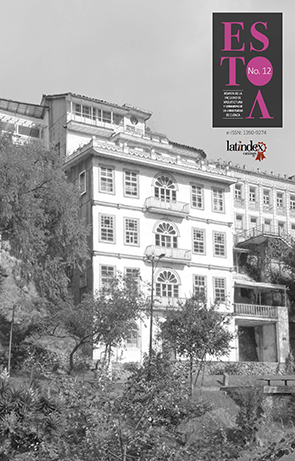The human host and the accessibility practices at Ouro Preto´s heritage city
DOI:
https://doi.org/10.18537/est.v007.n012.a07Abstract
Ouro Preto obtained the title Humanity's Cultural Heritage for UNESCO in 1980. the present research analyses the Tour Assistance Center (CAT) and the Inconfidência Museum: the first because of being located in the main means of transport of arrival to the city (bus station), where CAT positions receive the visitors; the second for the important representative symbolic mark and the central location at the Square of Tiradentes. The methodology of this research was based on the bibliographical inquiry in books, articles and thesis in the areas of cultural heritage, accessibility and host. Was carried out, still, with photographic registers in situ and analysis of perception in both study objects. The result of this, in spite of the difficulties of these institutions in projects of physical accessibility are built for the imposition of the legislation to preservation of heritage cultural and of the urbane topography itself, some projects was created and articulated to host the resident and the tourist. Meantime, for the bearers of reduced mobility is necessary to create tools of access that go besides the physical forms of the buildings with the intention of providing social inclusion.
Keywords: accessibility, heritage, Ouro Preto, reduced mobility.Downloads
References
Benjamin, Walter (1994). Magia e técnica. Arte e política: ensaios sobre literatura e história da cultura. São Paulo: Brasiliense.
Bourdieu, Pierre (2002). O poder simbólico. Rio de Janeiro: Bertrand Brasil.
Brusadin, Leandro Benedini; PANOSSO NETTO, Alexandre (2016). La dádiva y el intercambio simbólico. Estudios y Perspectivas em Turismo. Vol. 25.
Comandulli, Sandra Patricia Eder (2015). A ética da hospitalidade no reconhecimento do outro. Seminário de Pesquisa em Turismo do Mercosul, Caxias do Sul. Universidade Caxias do Suk, p. 3-8, agosto.
Derrida, Jacques (2004). Adeus a Emmanuel Lévinas. Perspectiva, São Paulo.
Godbout, Jacques T (1992). O Espírito da Dádiva. Paris: Edittions La Découverte.
Grinover, Lucio (2006) A Hospitalidade Urbana: acessibilidade, legibilidade e identidade. Revista Hospitalidade, São Paulo, ano III, n. 2, p. 29-50, 2. sem.
Kushano, Elizabete Sayuri; ALMEIDA, Wolney Gomes (2008). Inclusão Social, Cidadania e Turismo: uma investigação sobre a existência de serviços adaptados às pessoas com necessidades especiais nos meios de hospedagem da região metropolitana de Curitiba. Revista Brasileira de Pesquisa em Turismo, v. 2, n. 4, p. 88-101, dez.
Silva, Giordana Priscila Costa; BRUSADIN, Leandro Benedini ( 2013) Os Espaços da Hospitalidade e as Representações da Mineiridade nas Repúblicas Estudantis de Ouro Preto (MG). Revista Cenário, Brasília, V. 2, n.2, p. 141-161, set.
Manual sobre turismo accesible para todos (2017). Disponible en: http://www.accessibletourism.org/?i=enat.en.reports.1670. Acceso em 12/06/2017.
Melo, Natália Rodrigues de (2013). Pelos Percursos da Acessibilidade: afeto e apropriação nas ambiências de uma cidade histórica. Estudo de caso Em Ouro Preto, MG. Tese de Doutorado da Universidade Federal do Rio de Janeiro. Rio de Janeiro.
Mauss, Marcel (2008). Ensaio Sobre a Dádiva. Lisboa: Edições 70.
Montandon, Alain (2002). Ritos da hospitalidade erótica. In: DIAS, Celia Maria de Moraes (org.). Hospitalidade: reflexões e perspectivas: São Paulo: Manole.
Museologia – Roteiros práticos (2005). Resource: The Council for Museums, Archives and Libraries Acessibilidade/Resource: The Council for Museums, Archives and Libraries: São Paulo.
Nunes, Cláudia Alexandra de Almeida (2011) Turismo Acessível: o caso Lousã. 133f. Tese (Mestrado em Letras) - Faculdade de Letras da Universidade de Coimbra, Coimbra.
Xavier, Adriana Cristina (2006). O Papel Social do Turismo. Caderno Virtual de Turismo, Rio de Janeiro, v.6, n.1, p. 9-15.
Published
How to Cite
Issue
Section
License
The Journal declines any responsibility for possible conflicts derived from the authorship of the works that are published in it.
The University of Cuenca in Ecuador conserves the patrimonial rights (copyright) of the published works and will favor the reuse of the same ones, these can be: copy, use, diffuse, transmit and expose publicly.
Unless otherwise indicated, all contents of the electronic edition are distributed under a Creative Commons Attribution-NonCommercial-ShareAlike 4.0 International License.




